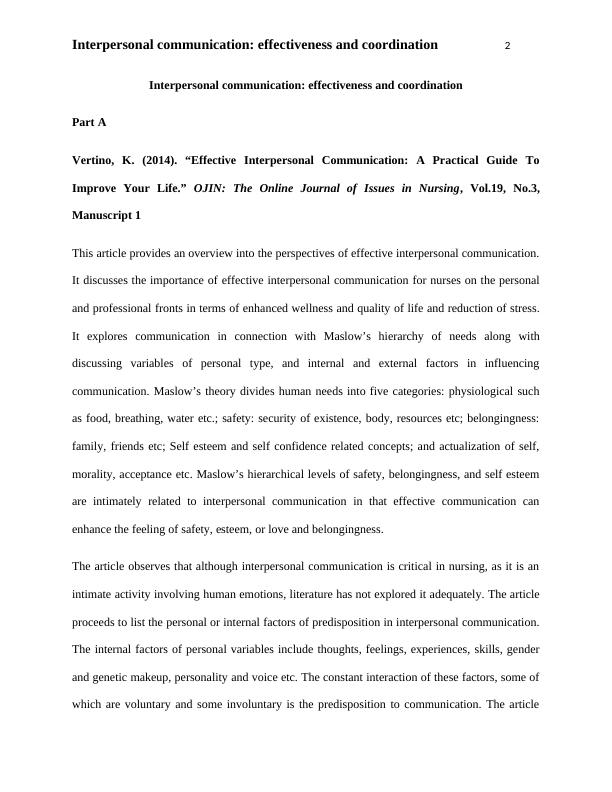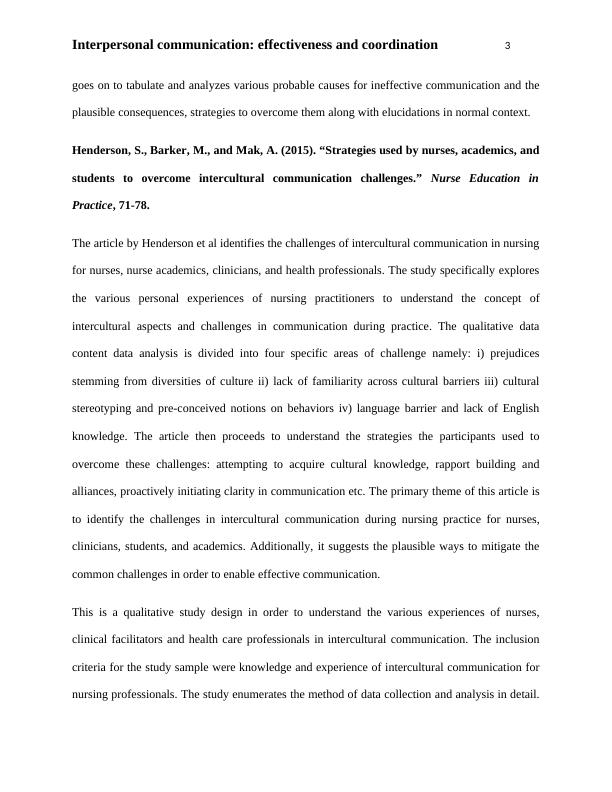Interpersonal communication: effectiveness and coordination
Added on 2019-12-17
7 Pages1649 Words186 Views
Interpersonal communication: effectiveness and coordination 1Interpersonal communication: effectiveness and coordinationStudent's Name:Instructor's Name:Date:

Interpersonal communication: effectiveness and coordination 2Interpersonal communication: effectiveness and coordinationPart AVertino, K. (2014). “Effective Interpersonal Communication: A Practical Guide ToImprove Your Life.” OJIN: The Online Journal of Issues in Nursing, Vol.19, No.3,Manuscript 1This article provides an overview into the perspectives of effective interpersonal communication.It discusses the importance of effective interpersonal communication for nurses on the personaland professional fronts in terms of enhanced wellness and quality of life and reduction of stress.It explores communication in connection with Maslow’s hierarchy of needs along withdiscussing variables of personal type, and internal and external factors in influencingcommunication. Maslow’s theory divides human needs into five categories: physiological suchas food, breathing, water etc.; safety: security of existence, body, resources etc; belongingness:family, friends etc; Self esteem and self confidence related concepts; and actualization of self,morality, acceptance etc. Maslow’s hierarchical levels of safety, belongingness, and self esteemare intimately related to interpersonal communication in that effective communication canenhance the feeling of safety, esteem, or love and belongingness.The article observes that although interpersonal communication is critical in nursing, as it is anintimate activity involving human emotions, literature has not explored it adequately. The articleproceeds to list the personal or internal factors of predisposition in interpersonal communication.The internal factors of personal variables include thoughts, feelings, experiences, skills, genderand genetic makeup, personality and voice etc. The constant interaction of these factors, some ofwhich are voluntary and some involuntary is the predisposition to communication. The article

Interpersonal communication: effectiveness and coordination 3goes on to tabulate and analyzes various probable causes for ineffective communication and theplausible consequences, strategies to overcome them along with elucidations in normal context.Henderson, S., Barker, M., and Mak, A. (2015). “Strategies used by nurses, academics, andstudents to overcome intercultural communication challenges.” Nurse Education inPractice, 71-78.The article by Henderson et al identifies the challenges of intercultural communication in nursingfor nurses, nurse academics, clinicians, and health professionals. The study specifically exploresthe various personal experiences of nursing practitioners to understand the concept ofintercultural aspects and challenges in communication during practice. The qualitative datacontent data analysis is divided into four specific areas of challenge namely: i) prejudicesstemming from diversities of culture ii) lack of familiarity across cultural barriers iii) culturalstereotyping and pre-conceived notions on behaviors iv) language barrier and lack of Englishknowledge. The article then proceeds to understand the strategies the participants used toovercome these challenges: attempting to acquire cultural knowledge, rapport building andalliances, proactively initiating clarity in communication etc. The primary theme of this article isto identify the challenges in intercultural communication during nursing practice for nurses,clinicians, students, and academics. Additionally, it suggests the plausible ways to mitigate thecommon challenges in order to enable effective communication.This is a qualitative study design in order to understand the various experiences of nurses,clinical facilitators and health care professionals in intercultural communication. The inclusioncriteria for the study sample were knowledge and experience of intercultural communication fornursing professionals. The study enumerates the method of data collection and analysis in detail.

End of preview
Want to access all the pages? Upload your documents or become a member.
